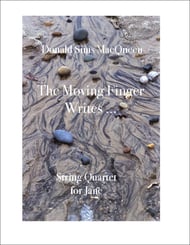
The Moving Finger Writes...
A String Quartet Sixty Years in the Making:
Virtually all the thematic material of my string quartet ‘The Moving Finger Writes’ was conceived long ago: the rondo theme and those of the first two episodes were written around 1960, and the theme of the third and fourth episodes around 1972-1973. In the mid-1980s I came upon the idea of stitching them all together into a string quartet with a title from a well-known poem from the Rubaiyat of Omar Kayyam (loosely translated into English from the Persian by Edward FitzGerald in 1859), and I started to work on this project soon after the first version of ‘Finale’ became available for computer notation and playback, in the late 1980s. I have thus worked on the quartet very sporadically throughout my life, since the age of fifteen, often with years of dormancy. I completed the quartet on September 2, 2021. The ‘Moving Finger Writes’ [“and having writ, moves on …”] framing suggests a path through life, a journey from innocence to experience.
The rondo them in C Major (originally written on the guitar) shows the way between (most of) the four episodes. The first gradually gathers itself into a theme of youthful exuberance, with a searching and surging perpetuum mobile foundation, starting in F Major, which is later capped by a harmonically buffeted yet resolute melody that first rises to a lofty—though suddenly fragile—tonic and then turns to slowly make its craggy way, constantly honed by shifting cadences, a full octave back to its home. In reprises, all of this is also punctuated by the insistent beckoning of a searing, falling descant. The second episode, in C Major, prematurely insinuates itself into the connecting rondo them before claiming its own dedicated space as a pensive, muted cousin to that rondo theme. This rondo connector returns, but it remains intertwined with its cousin in the lead-up to the third episode, in A minor. This episode is contrapuntal, pitting a bold, confrontational melody both against itself in a canon and against a set of interrogating counter motifs, which are also sometimes echoed in counterpoint. The countering motifs ultimately carry the day, having survived some threats to tonality. The connecting role of the rondo theme is then arrogated by a full-throated statement of the perpetuum mobile theme from episode one. This leads directly to the more complex fourth (final) episode, which is informed by a tension between F minor and D minor and comprises a self-contained sonata allegro. In the exposition, a restless, searching theme, over churning broken chords, soon undergoes a radical key change. The churning continues, now under Sturm und Drang-inspired pairs of probing suspensions, and when the rushing harmonies suddenly get ahead of themselves, their slippage spawns more innocent and carefree forays into melody. Ultimately, all this is dispelled, in waltz time, only to be repeated da capo. A development ensues, followed by a slightly expanded recapitulation. The quartet ends with an epilogue, consisting of a muted, pianissimo reprise of the rondo theme, with minimal vibrato (apart from the very last measure), ending with a repeat of the final cadence of the pensive C Major cousin, and fading away with glimpses of motifs acquired along the way.
I lovingly dedicate this string quartet to my wife, Jane Claire Davis MacQueen, whose spark brought so much of it to life.

































































































































